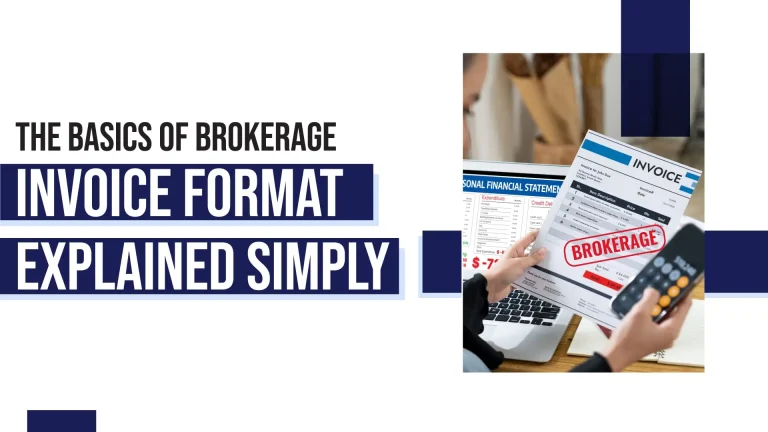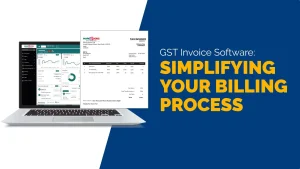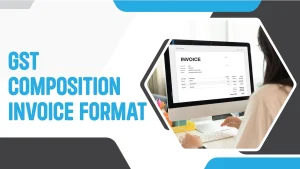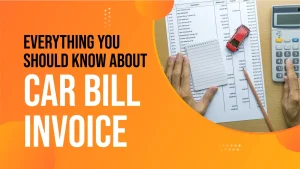Understanding the brokerage invoice format is crucial for anyone involved in real estate or stock market transactions. A brokerage invoice is a detailed bill provided by a broker, listing the services rendered and the corresponding fees. This document ensures transparency and helps maintain clear financial records. In this comprehensive guide, we will delve into the basics of the brokerage invoice format, its components, and why it is essential. We’ll use simple, conversational language to make the information accessible and easy to understand.
What is a Brokerage Invoice?
A brokerage invoice is a formal document issued by a broker to a client. It outlines the services provided by the broker, such as buying or selling securities, real estate transactions, or other financial services. The invoice includes a detailed breakdown of the fees associated with these services. This document serves as an official record of the transaction and is crucial for both the broker and the client to keep track of financial dealings.
Why is a Brokerage Invoice Important?
A brokerage invoice is important for several reasons. It provides a clear and detailed record of the services provided by the broker and the associated fees. This transparency helps build trust between the broker and the client. Additionally, it ensures that both parties have an accurate record of the transaction, which is essential for financial planning and record-keeping. A well-documented invoice can also prevent disputes and misunderstandings about the services rendered and the fees charged.
Components of a Brokerage Invoice
A brokerage invoice typically includes several key components. Each of these elements plays a vital role in ensuring that the invoice is clear and comprehensive. Let’s take a closer look at each of these components:
1. Header Information
The header section of a brokerage invoice includes basic information such as the broker’s name, address, contact details, and the invoice number. This section may also include the client’s name and contact information. The header helps identify the parties involved in the transaction and provides reference information for future correspondence.
- Broker’s Details
The broker’s details include the name of the brokerage firm or individual broker, their address, and contact information such as phone number and email address. This information is essential for the client to know who issued the invoice and how to contact them if needed.
- Client’s Details
The client’s details include the name, address, and contact information of the client receiving the invoice. This ensures that the invoice is directed to the correct person or entity.
- Invoice Number
The invoice number is a unique identifier assigned to each invoice. It helps in tracking and referencing the invoice in future communications or for record-keeping purposes.
2. Invoice Date and Due Date
The invoice date is the date when the invoice is issued. The due date indicates when the payment is expected. These dates are essential for tracking the timeline of the transaction and ensuring timely payments.
- Invoice Date
The invoice date is the specific date when the invoice is created and sent to the client. This date is important for both the broker and the client to keep track of when the transaction occurred.
- Due Date
The due date is the deadline by which the client needs to make the payment. This date helps ensure that payments are made on time and that there are no delays in settling the transaction.
3. Description of Services
This section provides a detailed description of the services rendered by the broker. It includes information such as the type of transaction (e.g., buying or selling securities), the quantity of assets involved, and any specific details relevant to the service. A clear and detailed description helps the client understand the charges and the services they are paying for.
- Service Details
The service details should be as specific as possible. For example, if the broker facilitated the purchase of stocks, the description should include the number of shares, the company’s name, and the date of the transaction. This clarity helps the client understand exactly what they are being charged for.
- Additional Information
If there are any additional services or special considerations, they should also be included in this section. This might include advisory services, research fees, or other related services that were provided during the transaction.
4. Fee Breakdown
The fee breakdown is a critical part of the brokerage invoice. It itemizes the costs associated with each service provided. This section may include various fees such as brokerage fees, commission fees, transaction fees, and any other applicable charges. A transparent fee breakdown helps prevent misunderstandings and disputes regarding the cost of services.
- Itemized Costs
Each service listed in the description should have a corresponding fee. This itemized list ensures that the client can see exactly what they are paying for and how much each service costs.
- Total Fees
The total fees section summarizes the individual costs to provide a final amount due. This helps the client understand the overall cost of the services provided.
5. Total Amount Due
The total amount due is the sum of all the fees listed in the fee breakdown. This section clearly states the total amount that the client needs to pay. Including the total amount due ensures that the client is aware of the full cost of the transaction.
- Calculating the Total
The total amount due is calculated by adding up all the itemized fees. This total should be clearly highlighted to make it easy for the client to see the final amount they owe.
6. Payment Instructions
Payment instructions provide the client with details on how to make the payment. This section may include the broker’s bank account information, payment methods accepted (e.g., bank transfer, check, credit card), and any specific instructions related to the payment process. Clear payment instructions help facilitate timely and accurate payments.
- Payment Methods
List all the acceptable payment methods, such as bank transfers, checks, or credit cards. This gives the client options for how they can make the payment.
- Bank Account Information
If the payment is to be made via bank transfer, include the broker’s bank account details, such as the account number, bank name, and any other necessary information.
7. Terms and Conditions
The terms and conditions section outlines any specific terms related to the payment and the services provided. This may include information about late payment penalties, refund policies, and any other relevant terms. Including terms and conditions helps ensure that both parties understand their obligations and rights.
- Late Payment Penalties
Clearly state any penalties that will be applied if the payment is not made by the due date. This helps ensure that the client is aware of the consequences of late payment.
- Refund Policies
If applicable, include information about the broker’s refund policy. This is important in case the client is not satisfied with the services provided and seeks a refund.
8. Signature Section
Some brokerage invoices include a signature section where both the broker and the client can sign to acknowledge the transaction. While not always required, this section can serve as an additional layer of verification and agreement between the parties.
- Broker’s Signature
The broker’s signature confirms that the invoice has been reviewed and approved by the broker or their representative.
- Client’s Signature
The client’s signature acknowledges receipt of the invoice and agreement to the terms and conditions outlined.
How to Create a Brokerage Invoice
Creating a brokerage invoice involves several steps. Here is a simple guide to help you create a comprehensive and professional brokerage invoice:
Step 1: Gather Necessary Information
Before creating the invoice, gather all the necessary information, including the broker’s details, client’s details, description of services, and fee breakdown. Having all the information at hand will make the process smoother and ensure that the invoice is accurate and complete.
Step 2: Use a Template
Using a template can help streamline the process of creating a brokerage invoice. There are many templates available online that can be customized to suit your needs. A template ensures that all the necessary components are included and provides a professional format for the invoice.
Step 3: Fill in the Details
Fill in the details gathered in Step 1 into the template. Ensure that all the information is accurate and complete. Double-check the details to prevent any errors or omissions.
Step 4: Review and Finalize
Review the invoice carefully to ensure that all the details are correct. Check for any errors or discrepancies and make any necessary corrections. Once you are satisfied with the invoice, finalize it by saving it in a suitable format (e.g., PDF) for distribution.
Step 5: Send the Invoice
Send the finalized invoice to the client. Ensure that the invoice is sent in a timely manner to allow the client sufficient time to review and make the payment by the due date.
Brokerage Invoice Format Example

Brokerage Invoice
| Description | Quantity | Unit Price | Total |
|---|---|---|---|
| Stock Purchase – XYZ Corp | 100 shares | $50.00 | $5,000.00 |
| Transaction Fee | 1 | $50.00 | $50.00 |
| Advisory Service | 1 hour | $200.00 | $200.00 |
Payment Instructions:
Please make the payment by the due date to the following bank account:
Bank Name: ABC Bank
Account Number: 123456789
Routing Number: 987654321
We accept bank transfers, checks, and credit card payments.
Terms and Conditions:
Payment is due within 30 days of the invoice date. Late payments will incur a penalty of 1.5% per month. For any queries, please contact us at (123) 456-7890 or email us at support@brokerage.com.
Importance of a Well-Structured Brokerage Invoice
A well-structured brokerage invoice is essential for several reasons. It provides a clear record of the transaction, ensuring that both the broker and the client have accurate and transparent information. This helps prevent disputes and misunderstandings regarding the services provided and the associated fees. Additionally, a detailed invoice aids in financial record-keeping, making it easier for both parties to track their expenses and revenues.
Ensures Transparency
Transparency is crucial in any financial transaction. A detailed brokerage invoice provides a clear breakdown of the services rendered and the associated fees. This transparency helps build trust between the broker and the client, ensuring that both parties are fully aware of the details of the transaction.
Facilitates Accurate Record-Keeping
Accurate record-keeping is essential for financial management. A well-structured brokerage invoice helps both the broker and the client maintain accurate financial records. This is important for tracking expenses, preparing tax returns, and managing budgets.
Prevents Disputes
Disputes can arise if there is a lack of clarity regarding the services provided and the associated fees. A detailed brokerage invoice helps prevent disputes by providing a clear and comprehensive record of the transaction. This ensures that both parties have a mutual understanding of the services rendered and the costs involved.
Aids in Financial Planning
For clients, a brokerage invoice is an important tool for financial planning. It provides a detailed breakdown of the costs associated with various transactions, helping clients budget and plan their expenses. For brokers, the invoice helps track revenues and manage their business finances effectively.
Conclusion
Understanding and using a proper brokerage invoice format is essential for maintaining clear and transparent financial transactions. A well-structured invoice helps build trust, prevent disputes, and facilitate accurate record-keeping. By following the steps outlined in this guide, you can create a comprehensive and professional brokerage invoice that meets the needs of both the broker and the client.
Also Read
- How to Ensure Data Security in Your Invoice Management SystemIn today’s digital age, businesses rely heavily on technology to streamline operations and improve efficiency. An invoice management system plays a crucial role in managing financial transactions and maintaining accurate records. However, with the increasing reliance on technology comes the… Read more: How to Ensure Data Security in Your Invoice Management System
- GST Invoice Software: Making Billing EasyIn today’s busy world of business, being efficient is super important. One big thing that needs to be super efficient is billing. With new technology, old-fashioned manual billing is out of date and can make a lot of mistakes. That’s… Read more: GST Invoice Software: Making Billing Easy
- GST Invoice Format for HotelIn the hospitality industry, especially for hotels, managing financial transactions is a very important task. One key part of this financial management is creating invoices that follow the rules of the Goods and Services Tax (GST) in India. Having a… Read more: GST Invoice Format for Hotel
- GST Composition Invoice FormatThe GST (Goods and Services Tax) Composition Scheme is a straightforward and user-friendly taxation scheme designed for small businesses in India. This scheme reduces the compliance burden for small taxpayers by allowing them to pay GST at a fixed rate… Read more: GST Composition Invoice Format
- Everything You Should Know About Car Bill InvoiceWhen it comes to car purchases, sales, repairs, or rentals, a car bill invoice is an essential document. This invoice serves as a record of the transaction and provides a detailed account of the services rendered or goods sold. Understanding… Read more: Everything You Should Know About Car Bill Invoice
Frequently Asked Questions
What is a brokerage invoice?
A brokerage invoice is a document issued by a broker to a client detailing the services provided and the associated fees. This invoice includes information like the broker’s and client’s details, a description of services, itemized costs, and the total amount due. It serves as a financial record of the transaction, helping both parties keep track of their expenses and revenues, ensuring transparency and preventing misunderstandings.
Why is a brokerage invoice important?
A brokerage invoice is crucial as it provides a clear, detailed record of the services rendered and fees charged, fostering transparency and trust between the broker and client. It helps prevent disputes by clearly outlining the costs and services. Additionally, it aids in accurate financial record-keeping and planning, making it easier for both parties to manage their finances and track their transactions. Having a well-documented invoice ensures all parties understand the terms and conditions of the services provided.
What details are included in a brokerage invoice?
A brokerage invoice typically includes the broker’s and client’s names, addresses, and contact details, an invoice number, the date of the invoice, and the due date. It also includes a detailed description of the services provided, an itemized breakdown of fees, the total amount due, payment instructions, and any terms and conditions. Some invoices may also have a signature section for both parties to acknowledge the transaction. These details ensure that the invoice is clear, comprehensive, and easy to understand.
How does a brokerage invoice ensure transparency?
A brokerage invoice ensures transparency by providing a detailed breakdown of the services provided and the corresponding fees. This clarity helps both the broker and the client understand what they are paying for and how much each service costs. By clearly outlining all the costs and services, the invoice helps prevent misunderstandings and disputes. It also builds trust between the broker and the client, as both parties have a clear and accurate record of the transaction.
What are the benefits of a well-structured brokerage invoice?
A well-structured brokerage invoice offers several benefits. It provides a clear record of the transaction, ensuring transparency and preventing disputes. It helps both the broker and the client maintain accurate financial records, aiding in financial planning and budgeting. Additionally, it ensures timely payments by clearly stating the payment terms and due date. A detailed invoice also helps build trust between the broker and the client, as it provides a clear and accurate record of the services provided and the associated fees.
What should I include in the description of services on a brokerage invoice?
The description of services on a brokerage invoice should include specific details about the services provided. For example, if the broker facilitated the purchase of stocks, the description should include the number of shares, the company’s name, and the date of the transaction. Any additional services, such as advisory or research fees, should also be included. Providing a detailed description helps the client understand what they are paying for and ensures that the invoice is clear and comprehensive.
How can I ensure my brokerage invoice is accurate?
To ensure your brokerage invoice is accurate, gather all necessary information before creating the invoice. Use a template to ensure all essential components are included. Double-check the details, including the broker’s and client’s information, description of services, itemized fees, and total amount due. Review the invoice carefully for any errors or discrepancies and make any necessary corrections. Finally, ensure that the invoice is clear and easy to understand, and provide accurate payment instructions and terms and conditions.
What are the common mistakes to avoid when creating a brokerage invoice?
Common mistakes to avoid when creating a brokerage invoice include missing or incorrect information, unclear descriptions of services, and errors in the fee breakdown or total amount due. Ensure all necessary details are included, such as the broker’s and client’s information, invoice number, dates, and payment instructions. Provide clear and detailed descriptions of services and itemized costs. Double-check for any errors or discrepancies before finalizing the invoice. Avoid using overly technical language or jargon, and ensure the invoice is clear and easy to understand.
How can a brokerage invoice help in financial planning?
A brokerage invoice helps in financial planning by providing a detailed record of the services provided and the associated costs. For clients, it helps track expenses and plan budgets by clearly outlining the costs of various transactions. For brokers, it helps track revenues and manage business finances. The detailed breakdown of fees and services helps both parties maintain accurate financial records, which is essential for budgeting, preparing tax returns, and managing overall finances.
What are the payment instructions on a brokerage invoice?
Payment instructions on a brokerage invoice provide details on how the client should make the payment. This section may include the broker’s bank account information, acceptable payment methods (e.g., bank transfer, check, credit card), and any specific instructions related to the payment process. Clear payment instructions help facilitate timely and accurate payments, ensuring that the transaction is completed smoothly. Providing multiple payment options can also make it easier for the client to make the payment on time.





